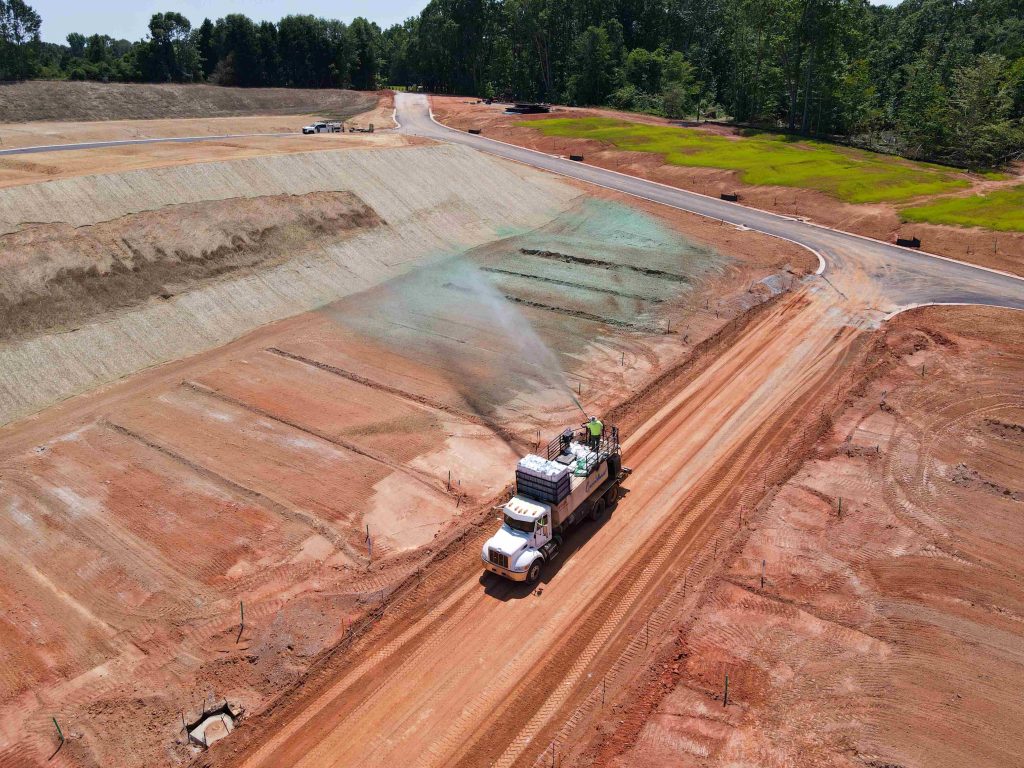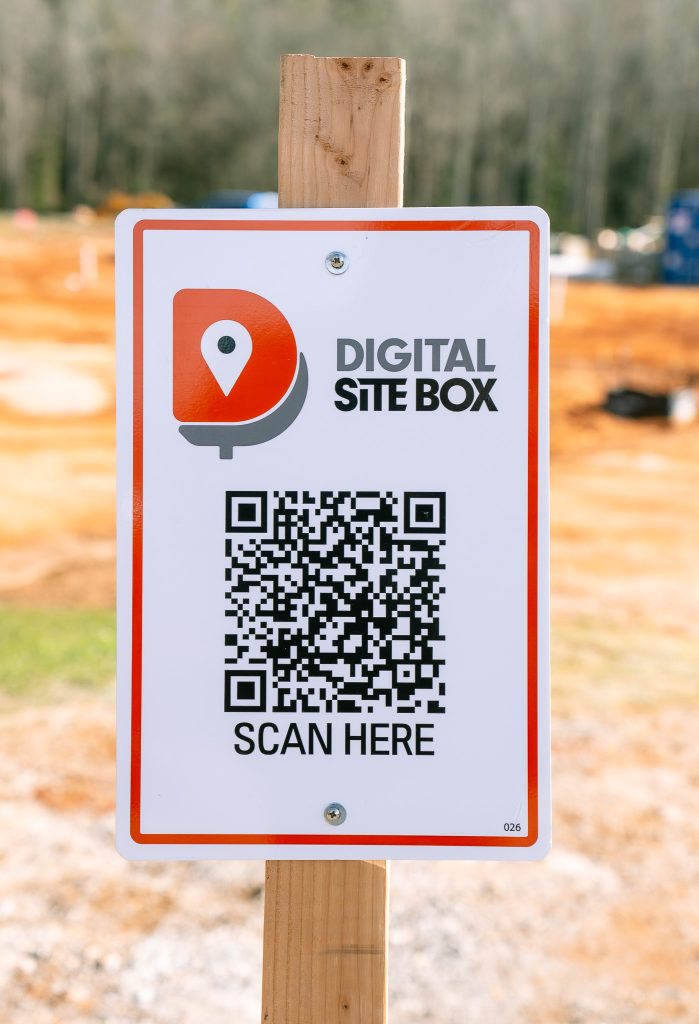
Table of Contents
- Key Points
- Understanding Erosion in South Carolina’s Unique Environment
- The Business Case for Professional Erosion Control
- Essential Erosion Control Methods for Construction Sites
- Erosion Control Landscaping: Beauty Meets Function
- Choosing the Right Erosion Control Company
- Learn More About Erosion Control Strategies and Practices
- References
Key Points
- Construction sites are significantly more prone to soil erosion than agricultural land.
- Implementing professional erosion control—which involves the combination of strategic temporary and permanent measures—is a critical business practice that prevents costly project delays, fines, and remediation efforts, while protecting long-term property value.
- Understanding what professional erosion control measures entail and how to employ them is central to ensuring the integrity of any major project.
The USDA estimates that construction sites can lose soil as much as 100 times faster than agricultural land. There are three main reasons for this: removal of vegetation and subsoil ( leaves the subsoil vulnerable, soil compaction (making it harder to absorb water), and the creation of steel slopes (accelerate the flow of water).1
For construction companies and property owners in the Greenville area, this reality makes erosion control not just an environmental consideration, but a critical component of project success and long-term property value protection.
At Collins Hammett Construction, we have witnessed firsthand how proper erosion control strategies can make the difference between a successful project and costly delays, fines, and remediation efforts. The information below explains the dynamics of erosion control and lays out the fundamentals of soil stabilization and water management.
Understanding Erosion in South Carolina’s Unique Environment
South Carolina’s climate and topography present unique challenges for construction projects. The region averages around 50 inches of rain every year.2 This, combined with intense thunderstorms and occasional tropical weather systems, creates conditions where unprotected soil can quickly become a liability. The Upstate is also particularly susceptible to erosion due to its rolling terrain and clay-rich soils that become easily saturated and unstable when disturbed.
Key environmental factors affecting erosion in our region include:
- Seasonal rainfall patterns – Heavy spring rains and summer thunderstorms can overwhelm inadequate drainage systems.
- Clay soil composition – Becomes impermeable when wet, leading to increased runoff and erosion potential.
- Topographical variations – Slopes and elevation changes accelerate water flow and soil displacement.
- Vegetation disruption – Construction activities remove natural root systems that normally stabilize soil.
- Temperature fluctuations – Freeze-thaw cycles can further destabilize exposed soil surfaces.
The Business Case for Professional Erosion Control
Beyond environmental stewardship, implementing effective erosion control measures makes solid business sense. Construction projects that fail to address erosion adequately often face significant financial consequences that far exceed the cost of proper prevention measures.
Financial benefits of proactive erosion control include:
- Reduced project delays – Proper soil management prevents weather-related work stoppages.
- Lower remediation costs – Prevention is always more cost-effective than cleanup and repair.
- Regulatory compliance – Avoiding EPA and state environmental fines and penalties.
- Insurance advantages – Many insurers offer reduced premiums for projects with comprehensive erosion control plans
- Enhanced property values – Well-managed sites maintain better long-term stability and aesthetics.
- Improved community relations – Demonstrating environmental responsibility builds positive stakeholder relationships.
Essential Erosion Control Methods for Construction Sites
Selecting the right erosion control method depends on various factors, including site topography, soil type, project timeline, and local regulations. A professional erosion control company typically will employ a combination of temporary and permanent solutions tailored to each project’s specific needs.

Temporary Erosion Control Solutions
- Silt fencing and sediment barriers:
- Fabric barriers that filter runoff while allowing water to pass through slowly.
- Ideal for perimeter protection and staging area isolation.
- Cost-effective for short-term construction phases.
- Requires regular inspection and maintenance for optimal performance.
- Erosion control blankets and mats:
- Biodegradable or synthetic materials that protect exposed soil surfaces.
- Excellent for slope stabilization during vegetation establishment.
- Available in various materials including coconut fiber, straw, and polypropylene.
- Provides immediate protection while allowing plant growth underneath
- Temporary seeding and hydroseeding:
- Quick-growing grass species that provide rapid soil stabilization.
- Hydroseeding offers superior coverage on difficult terrain.3
- Cost-effective solution for areas disturbed for extended periods.
- Can be combined with other methods for enhanced effectiveness.
Permanent Erosion Control Solutions
- Retaining walls and structural controls:
- Engineered solutions for significant elevation changes and unstable slopes.
- Materials include concrete, stone, timber, and modular block systems.
- Provide long-term stability for challenging topographical conditions.
- Often required for commercial developments with substantial grading.
- Drainage systems and stormwater management:
- Properly designed channels, culverts, and retention ponds.
- Critical for managing water flow and preventing erosion at source.
- Must comply with local stormwater regulations and permit requirements.4
- Integration with natural drainage patterns maximizes effectiveness
Erosion Control Landscaping: Beauty Meets Function
Modern erosion control landscaping approaches recognize that environmental protection and aesthetic appeal can work hand in hand. This integrated approach is particularly valuable for commercial properties where visual impact affects business success and property values.
Native plant selections for erosion control5
- Switchgrass and little bluestem – Deep-rooted prairie grasses ideal for slopes
- Lespedeza and crown vetch – Legumes that improve soil while preventing erosion
- Virginia creeper and native honeysuckle – Ground covers for steep areas
- Red oak and sweetgum saplings – Trees that provide long-term soil stabilization
- Native ferns and wildflowers – Understory plants that complete the ecosystem
Landscaping techniques that control erosion
- Terracing and contouring – Reshaping terrain to slow water flow and reduce erosion potential.
- Strategic plant placement – Using vegetation patterns to direct and filter stormwater.
- Mulching and organic matter – Improving soil structure and water retention capacity.
- Rock gardens and hardscaping – Incorporating decorative elements that provide functional erosion control.
- Rain gardens and bioswales – Attractive features that manage runoff while supporting wildlife.
Choosing the Right Erosion Control Company
Selecting a qualified erosion control company is crucial for project success. The complexity of modern regulations, combined with the technical expertise required for effective implementation, makes professional guidance essential for most commercial construction projects.
Key qualifications to look for:

- Local experience and knowledge – Understanding of regional soil types, climate, and regulations.
- Comprehensive service offerings – Ability to handle both temporary and permanent solutions.
- Regulatory expertise – Current knowledge of federal, state, and local requirements.
- Project management capabilities – Coordination with other construction activities and timeline management.
- Technological tools – Access to the most current and innovative tools, like Digital Site Box, for efficiently and expertly completing a project.
- Quality assurance programs – Regular monitoring and maintenance protocols.
- Environmental credentials – Certifications and training in sustainable practices.
Questions to ask potential contractors:
- What specific experience do you have with projects similar to ours?
- Can you provide references from recent commercial construction projects in the Greenville area?
- How do you ensure compliance with current environmental regulations?
- What warranty or guarantee do you provide on your erosion control installations?
- How do you handle maintenance and monitoring during the construction phase?
- What backup plans do you have if initial control measures prove inadequate?
Learn More About Erosion Control Strategies and Practices
Effective erosion control is more than an environmental requirement—it’s a fundamental component of successful construction project management. By working with experienced professionals who understand the unique challenges of building in South Carolina’s dynamic environment, property owners and developers can protect their investments while contributing to the long-term sustainability of our region’s natural resources.
As a leading construction company serving Upstate South Carolina, Collins Hammett brings decades of experience in implementing effective erosion control solutions for commercial projects throughout the region. Our comprehensive approach integrates erosion control planning into every phase of construction, from initial site assessment through final stabilization and landscaping.
We pride ourselves on site-specific design tailored to local conditions and project requirements, combined with integrated project management, quality monitoring and adjustment, and post-construction support for long-term stability. Reach out to us today to discuss your project goals and erosion control goals.
References
- Hongliang Tang, Pengkun Shi, and Xiaoli Fu, “An Analysis of Soil Erosion on Construction Sites in Megacities Using Analytic Hierarchy Process,” Sustainability, January 2023, https://www.mdpi.com/2071-1050/15/2/1325.
- “Greenville County Climate Data,” South Carolina State Climatology Office, retrieved on September 19, 2025, from: https://www.dnr.sc.gov/climate/sco/ClimateData/countyData/county_greenville.php.
- Lee Wallender, “What Is Hydroseeding and How Much Does It Cost?” The Spruce.com, June 2024, https://www.thespruce.com/hydroseeding-cost-7554433.
- “Stormater Management Design Manual, Greenville County.org, September 2021, https://www.greenvillecounty.org/LandDevelopment/DesignManual.aspx.
- “Reducing Erosion with Native Plants,” National Park Service, June 2021, https://www.nps.gov/articles/000/reducing-erosion-with-native-plants.htm.

Thomas R. Strange III is a member at Collins Hammett Construction, LLC, located in Upstate, SC. He grew up in the grading industry, starting his career with summer and after-school jobs in 1992. In 1997, he began working full-time, running equipment for numerous projects in the area. Find him on LinkedIn.